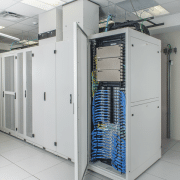Do You Need an IP67 Ethernet Switch? Ask These Questions First
Written by Rick Saro and Mike Krueger

In automotive environments, Ethernet switches make it possible to connect essential devices to the network so they can gather data and communicate.
Choosing the right Ethernet switch often comes down to deciding between IP ratings: an IP20 or IP67 switch. Both serve the same purpose but offer different advantages and drawbacks you should consider.
An IP20 switch is installed in a control cabinet, considered touchproof (users won’t make contact with hazardous or energized parts) and prevents ingress of large dust particles.
IP67 switches allow equipment operators to deploy Ethernet-based systems right at a machine, process or factory floor instead of in a cabinet. This allows them to configure, manage and monitor connected machines and devices remotely—outside the control cabinet—without having to run long lengths of cable or install enclosures for switches and powering devices.
Due to many factors—including their space-saving, cabinet-less design—IP67 switches are sometimes considered the automotive manufacturing industry’s go-to option for Ethernet switches. But does your plant environment really need an IP67 switch? Would an IP20 switch work just as well?
In some environments, IP67 switches may be necessary. In other cases, however, IP20 switches may be the more cost-effective choice.
Which IP-rated Ethernet switch is right for your automotive plant? To find out, ask yourself these questions …
1. Is There Moisture or Frequent Washdowns?
Water plays a big role in the automotive manufacturing process, and it’s used in a number of different stages in an assembly line.
These applications might include:
- Paint booths where water is used as a filtration medium
- Rinsing and metal finishing
- Processing equipment that must be regularly cleaned with water
- Body-washing areas where cars are cleaned before leaving the plant
- Rain test chambers that ensure water tightness
If an Ethernet switch will be deployed in a water-intense production area, then it needs to be protected from water intrusion. To protect against water ingress, IP67 Ethernet switches rely on M12 connectivity instead of the RJ45 connectivity found with IP20 switches.
2. Are Dust and Debris Present?
When employees are running the production line, their work often results in large volumes of dust. When a significant amount of dust is present in your manufacturing environment, Ethernet switches need to be able to guard against significant dust intrusion to remain operational.
These types of dust-generating applications can include:
- Cutting
- Grinding
- Machining
- Plastic processing
- Rubber manufacturing
- Stamping
- Welding
IP20 switches prevent ingress of particles greater than 12 mm in diameter, which provides a reasonable level of protection against dust. IP67 switches are considered completely dust tight, offering full protection from dust and other particulates.
3. Do We Need Clear Lines of Sight?
Is having a clear line of sight to production lines important in your plant to support communication, determine when assistance is needed, watch for alerts, maintain productivity or ensure that quality standards are met?
Because IP67 switches can be installed outside protective cabinets and directly on machines, they don’t create any visual clutter that may impede the ability to see production lines or interfere with visual verification.
4. Do Control Cabinets Need More Space?
Real estate can be one of the biggest expenses involved with running a plant. Maximizing space inside control cabinets can help reduce the size and footprint of the cabinets themselves, optimize plant square footage and reduce labor and material costs.
If you need to find ways to optimize the space inside your automotive plant’s control cabinets, then an IP67 Ethernet switch’s cabinet-less design can help you do this. When the switch is mounted outside the cabinet and directly at the machine, this also results in shorter cable runs (saving even more labor and material costs).
5. Is Maintenance a Concern?
Many U.S. requirements state that electricians must dress in personal protective equipment, including clothing that doesn’t conduct electricity, before accessing a cabinet housing containing 110V service or higher. If an IP20 switch is inside the cabinet, then electricians must be the ones to access it.
IP67 switches eliminate this requirement—and the potential for arc flash—because the switches can be removed from enclosures and cabinets while still ensuring reliable performance in dusty, wet and harsh environments.
Mounting Ethernet switches outside the control cabinet also reduces the amount of time an electrician spends working inside a cabinet, improving life safety.
Making the Right Choice
If the factors mentioned above—water and dust ingress, space optimization, maintenance and clear lines of sight—are important to your manufacturing operation, then IP67 switches may be the best choice for your automotive environment.
If these factors aren’t a major concern, however, then IP20 switches can be a practical and cost-effective solution to support your connectivity goals.
For automotive environments that demand IP67 Ethernet switches, Belden offers its OCTOPUS IP67 Ethernet Switch. It allows automotive plants to install reliable, fail-safe networks in demanding conditions. Available in unmanaged and managed versions, they offer a cabinet-less design for easy installation directly on machines, built-in network security and complete protection against dust and water intrusion.
Learn more about OCTOPUS IP67 Switches
Find the original article here









